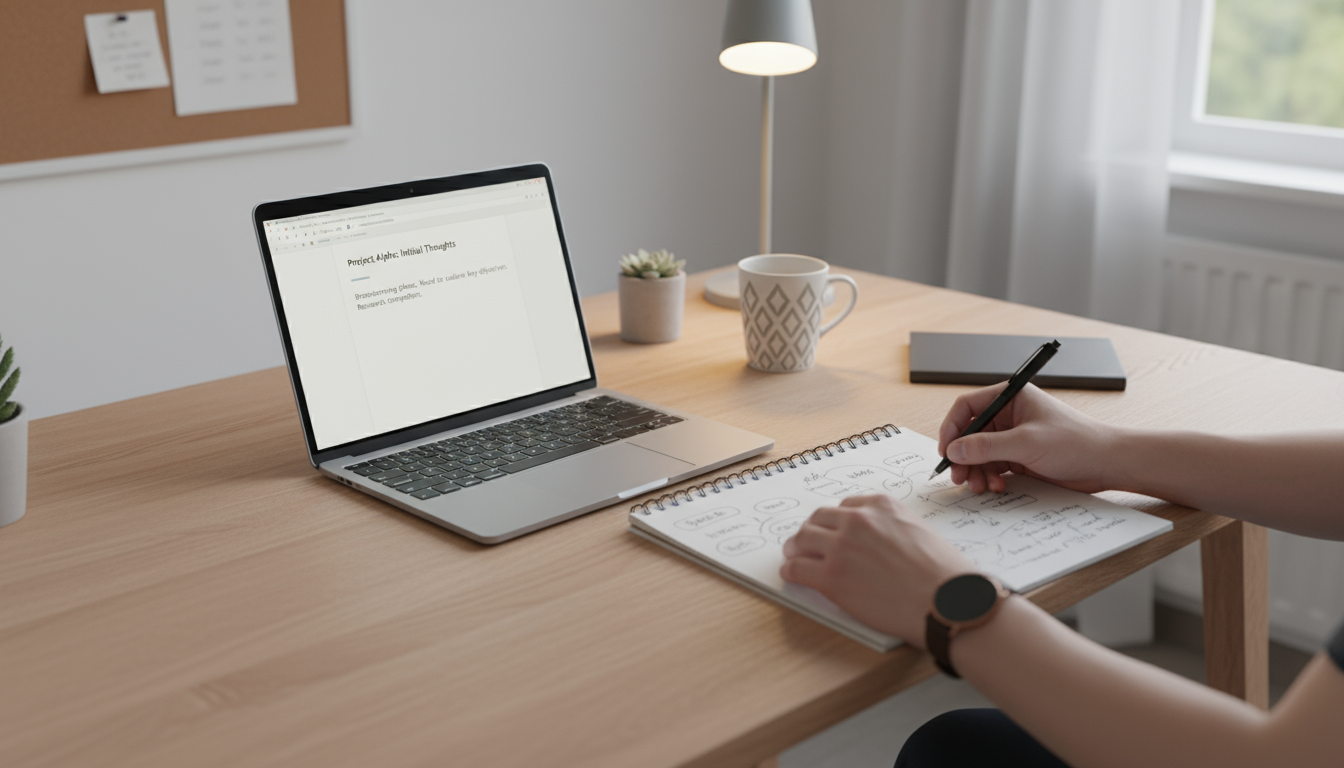
Does your mind ever feel like a browser with too many tabs open? You sit down to work on one important task, but a dozen other thoughts, worries, and digital notifications are all vying for your attention. You feel a constant, low-grade hum of mental friction. You know you need to focus, but the very act of trying feels exhausting. If this sounds familiar, you are not alone. This state of persistent distraction has become our modern default.
But what if I told you there was a way to quiet the noise? A way to work with your brain, not against it, to achieve a state of clear, productive, and deeply satisfying focus. This state is often called deep work, a term for the ability to focus without distraction on a cognitively demanding task. It’s the state where you produce your best work, learn complex skills, and feel a genuine sense of accomplishment.
This isn’t about willpower or forcing yourself to concentrate through sheer grit. It’s about understanding the science of how your brain is wired for focus and creating simple, powerful rituals that make concentration the path of least resistance. Your brain doesn’t want to be scattered; it actually craves the order and reward that comes from sustained attention. It’s designed to thrive in it.
In this guide, we won’t just talk about the theory. We’ll give you practical, step-by-step focus rituals you can start using today. We’ll explore how to reframe your mindset, manage your energy, and build a system that makes deep work a natural part of your day. Prepare to close some of those mental tabs and discover the profound calm and capability that’s waiting on the other side.
📚 Table of Contents
- Understanding Your Brain’s Attention System
- The Four Essential Rituals for Deep Work
- 1. The Startup Ritual: Priming Your Day for Intention
- 2. The Deep Work Entry Ritual: Crossing the Threshold into Focus
- 3. Break Hygiene: The Art of a Restorative Pause
- 4. The Shutdown Ritual: Ending the Day with Clarity
- Your 15-Minute Deep Work Starter Pack
- Mind Over Matter: Thought Tools for Lasting Focus
- Reframe Perfectionism as a Form of Procrastination
- Design Your Environment to Reduce Friction
- Create a Simple “Reset” Script for When You Get Derailed
- Deep Work in the Real World: Two Scenarios
- Your Focus Questions, Answered (FAQ)
- Should I listen to music or use white noise?
- But isn’t multitasking necessary in my job?
- What if I have zero motivation to start?
- Can I do deep work in the evenings or on weekends?
- Your Seven-Day Focus Challenge

Understanding Your Brain’s Attention System
To master focus, we first need to understand the beautiful, complex, and sometimes frustrating machine we’re working with: our brain. Think of your brain’s capacity for attention not as an infinite resource, but as a finite energy reserve. Every decision you make, every notification you check, and every thought you entertain draws from this reserve. This is where a few key concepts come into play.

The Enemy of Focus: Cognitive Load and Context Switching
Your brain has a limited amount of processing power available at any given moment. This is what neuroscientists call cognitive load. It’s the total amount of mental effort being used in your working memory. When you try to do too many things at once—like writing a report while monitoring emails and listening to a podcast—you overload your cognitive capacity. Nothing gets your full, high-quality attention. The result is shallow work, more errors, and mental exhaustion.
The primary culprit behind cognitive overload is context switching. This is the act of moving from one unrelated task to another. Every time you switch, your brain pays a tax. It has to disengage from the first task, load the “rules” and context for the new task, and then ramp up. A quick glance at your phone might seem harmless, but it can take many minutes for your brain to fully re-engage with the complex task you left behind. According to research in human-computer interaction and psychology, these switches, even if brief, can significantly decrease productivity and increase error rates. For more on the foundational principles of psychology, the American Psychological Association is a valuable resource.
The solution? Monotasking. It’s the simple, revolutionary act of doing one thing at a time. By dedicating your full cognitive resources to a single task, you allow your brain to work as it was designed: deeply and efficiently. Monotasking isn’t a limitation; it’s a superpower for producing high-quality work.

Finding Your Rhythm: Energy and Flow
Your ability to focus isn’t constant throughout the day. It ebbs and flows in natural cycles known as ultradian rhythms. These are 90-to-120-minute cycles where your brain moves from a state of high alertness to one of lower alertness, needing a period of rest and recovery. Pushing through these natural lulls is like driving a car with the emergency brake on. You can do it, but it’s inefficient and causes unnecessary wear and tear.
Working with these rhythms, rather than against them, is the key to sustainable focus. This means working in focused bursts of 60 to 90 minutes, followed by a genuine break of 15 to 20 minutes. During these breaks, you allow your brain’s energy reserves to replenish, setting you up for another productive session.
When you align monotasking with your natural energy rhythms, you create the ideal conditions for a state of flow. You’ve probably experienced this before. Flow is that magical state of being “in the zone,” where you are so fully immersed in an activity that you lose track of time. Your sense of self fades, your concentration is effortless, and your performance skyrockets. This is the ultimate reward of deep work. It’s not just productive; it’s deeply fulfilling. Your brain releases a cocktail of rewarding neurochemicals like dopamine and norepinephrine, which makes you feel good and reinforces the very behavior that got you there. In essence, your brain learns to love the feeling of focus.

The Four Essential Rituals for Deep Work
Deep work doesn’t just happen. It’s cultivated. The most effective way to make focus a habit is to build a reliable system of rituals. Rituals are powerful because they automate behavior, reducing the need for willpower and decision-making. Instead of wondering if you’ll focus, your rituals make it a matter of when. Here are the four cornerstones of a deep work practice.

1. The Startup Ritual: Priming Your Day for Intention
How you start your day sets the tone for everything that follows. A startup ritual is a short, consistent routine that transitions you from a reactive state to a proactive one. It’s about taking control of your day before it takes control of you. Instead of jumping straight into your inbox, which immediately puts you in a reactive mode of responding to others’ agendas, you take a few minutes to define your own.
Your startup ritual could be as simple as sitting down at your desk with a cup of coffee and a piece of paper. Before you open your laptop, you answer three questions: What is the most important thing I need to accomplish today? What potential distractions might get in my way? What will my first deep work session be, and when will it happen? This simple act of planning shifts your mindset from passive to purposeful. You are no longer just reacting to the day; you are directing it.

2. The Deep Work Entry Ritual: Crossing the Threshold into Focus
Just as an athlete warms up before a game, your brain needs a brief transition to enter a state of deep focus. An entry ritual is a simple, repeatable sequence of actions that signals to your brain: “It’s time to concentrate.” This could take just two minutes, but its effect is profound.
An effective entry ritual might look like this: you clear your desk of everything except what you need for the task. You pour a glass of water. You put on noise-canceling headphones. You close all unrelated browser tabs and applications. You set a timer for your intended work session, perhaps 75 minutes. Finally, you state your intention out loud: “For the next 75 minutes, I am going to focus solely on drafting the project proposal.” This series of small actions creates a clear boundary between distraction and deep work, making it much easier to cross over.

3. Break Hygiene: The Art of a Restorative Pause
The work you do during your breaks is just as important as the work you do during your focus sessions. Poor break hygiene—like scrolling through social media or checking emails—doesn’t allow your brain to truly rest. It just swaps one form of cognitive load for another, leaving you feeling drained and unfocused when you return to your work.
Good break hygiene involves activities that are genuinely restorative. The goal is to give your prefrontal cortex, the part of your brain responsible for executive functions like focusing, a real rest. This means stepping away from screens. Stand up, stretch, and walk around. Look out a window at something in the distance to relax your eyes. Hydrate. Do a few minutes of mindful breathing. Have a conversation with a colleague about something other than work. These activities help replenish your mental energy, ensuring your next deep work session is just as productive as your first.

4. The Shutdown Ritual: Ending the Day with Clarity
One of the biggest obstacles to rest and relaxation is the lingering feeling that your work is never truly done. A shutdown ritual is a formal process for ending your workday that gives your brain a clear signal that it’s time to disengage. This prevents work from bleeding into your personal time and helps you start the next day with a clean slate.
Your shutdown ritual should take about 10 to 15 minutes. First, review your to-do list and your calendar. Transfer any unfinished tasks to the next day’s plan. This reassures your brain that nothing will be forgotten. Second, quickly organize your physical and digital workspace. Close your tabs, tidy your desk. Finally, say a consistent phrase to mark the end of the day, such as “Shutdown complete.” This simple act creates a powerful psychological boundary, allowing you to be fully present in your evening without the nagging anxiety of unfinished work.

Your 15-Minute Deep Work Starter Pack
Feeling overwhelmed by all of this? Let’s make it simple. Here is a 15-minute routine you can try tomorrow. Think of it as a single “rep” of deep work.
First, choose one small, specific task that requires your focus. Next, perform a one-minute entry ritual: silence your phone and move it out of sight, close all other tabs, and set a timer for 15 minutes. For those 15 minutes, commit to working only on that single task. When the timer goes off, stop. Take a five-minute restorative break where you stand up, stretch, and get a glass of water. Do not check your phone. After your break, perform a one-minute shutdown: write down the very next step you’ll take on that task when you return to it. That’s it. You’ve just completed a full deep work cycle. Start here, and you can gradually extend the time as your focus “muscle” gets stronger.

Mind Over Matter: Thought Tools for Lasting Focus
Building a system of rituals is crucial, but the greatest barrier to focus often lies between our ears. Our mindset, self-talk, and emotional responses can either support or sabotage our best intentions. Here are three powerful mental tools to help you win the inner game of focus.

Reframe Perfectionism as a Form of Procrastination
Perfectionism often masquerades as a commitment to high standards, but in reality, it’s a powerful engine for procrastination. The fear of not doing something perfectly can be so paralyzing that it prevents us from even starting. We wait for the “perfect” time, the “perfect” idea, or the “perfect” mood, and as a result, our most important work remains undone.
The antidote is to reframe your goal from “doing it perfectly” to “getting it started.” Give yourself permission to produce a messy first draft. Embrace the mantra, “Good enough is the new perfect.” The goal of your first deep work session on a project isn’t to finish it; it’s simply to begin. You can always revise and improve later. By lowering the stakes, you remove the primary source of friction that keeps you from diving in. Remember, progress is more valuable than perfection.

Design Your Environment to Reduce Friction
Our brains are wired to follow the path of least resistance. If distraction is easy and focus is hard, your brain will choose distraction every time. The secret is not to rely on willpower, but to intentionally design your environment so that focus is the easiest option.
This is about reducing friction for desired behaviors and increasing friction for undesired ones. Want to focus on writing? Make it easy. Leave the document open on your screen at the end of the day. Put the book you need for research right on your keyboard. Want to stop checking your phone? Make it hard. Log out of distracting apps. Move the device to another room. Put it in a drawer. Every extra step you add between you and a distraction is another opportunity for your conscious mind to intervene and say, “Wait, is this really what I want to be doing right now?” A well-designed environment acts as a silent partner in your quest for focus.

Create a Simple “Reset” Script for When You Get Derailed
No matter how perfect your system is, you will get distracted. A thought will pop into your head. A colleague will interrupt you. You’ll find yourself mindlessly scrolling. This is not a failure; it is a normal part of the human experience. The crucial moment is not the distraction itself, but what you do immediately after you notice it.
Many of us react with harsh self-criticism: “Ugh, I can’t believe I wasted 10 minutes. I have no self-control.” This kind of negative self-talk only adds a layer of shame and stress, making it even harder to refocus. Instead, you need a simple, compassionate, and non-judgmental reset script. The moment you realize you’re off-task, gently say to yourself, “Okay, I was distracted. That’s fine. What’s the next small action I need to take?”
This script does two things. First, it acknowledges the distraction without judgment, which diffuses the negative emotional charge. Second, it immediately orients your brain back toward the task at hand. It’s a moment of gentle redirection, not recrimination. By practicing this compassionate reset, you train your brain to see distractions not as failures, but as simple, fixable detours on the path back to deep work.

Deep Work in the Real World: Two Scenarios
Theory is one thing, but applying these principles in the chaos of daily life is another. Let’s walk through two common, challenging scenarios to see how these rituals and thought tools can be adapted to the real world.

Scenario 1: The Tight Deadline
Imagine you have a major project due in 48 hours. The pressure is immense, and your instinct is to panic, multitask, and work nonstop. This, however, is a recipe for burnout and sloppy work. Here’s how to apply the deep work method instead.
The Action Plan: First, you perform an emergency startup ritual. You take 10 minutes to map out the entire project. You break it down into small, concrete tasks and estimate the time needed for each. This clarity immediately reduces overwhelm. You then schedule your next 48 hours not as one long slog, but as a series of 90-minute deep work blocks separated by 20-minute restorative breaks. You honor these breaks ruthlessly, knowing they are essential for maintaining peak cognitive performance. For each block, you perform your two-minute entry ritual, focusing on only one task at a time. You increase friction for distractions by setting an “out of office” on your email and putting your phone on airplane mode. If you feel panic rising, you use your reset script: “Okay, I’m feeling stressed. That’s normal. What is the very next task on my list?” By imposing structure on the chaos, you work with calm, focused intensity instead of frantic, scattered energy.

Scenario 2: The Noisy Home Environment
You work from home, but your environment is far from a peaceful sanctuary. Your kids are on school break, your partner is on calls in the next room, and construction is happening outside. It feels impossible to concentrate.
The Action Plan: This situation calls for a focus on environmental design and expectation management. First, noise-canceling headphones are your best friend. They are a powerful signal to both your brain and your family that you are in focus mode. Second, you have a brief, explicit conversation with your family. You might say, “I need to do some really focused work. Between 10:00 and 11:30, when this door is closed and my headphones are on, please only interrupt me for a true emergency.” This sets a clear boundary. You might also adapt your work schedule to your environment, scheduling your deepest work for early in the morning or during a child’s naptime. You also practice your compassionate reset script frequently, because interruptions will still happen. Instead of getting frustrated, you handle the interruption calmly and then use your entry ritual to guide your brain back to the task. You focus on what you can control—your immediate workspace, your signals, and your reactions—rather than what you can’t.

Your Focus Questions, Answered (FAQ)
As you begin your deep work journey, questions will naturally arise. Here are answers to some of the most common ones we hear from people trying to build their focus.
Should I listen to music or use white noise?
This is highly individual. For some, the right kind of music—typically instrumental, ambient, or electronic music without lyrics—can help mask distracting background noise and signal to the brain that it’s time to focus. For others, any sound, even music, is a distraction. White noise or brown noise can be a great alternative, as it provides a consistent sonic blanket that blocks out sudden, jarring noises. The key is to experiment. Try working in complete silence, then with ambient music, then with white noise. See what helps you achieve a state of flow most easily. The goal is to find a soundscape that supports your focus, rather than competes for it.
But isn’t multitasking necessary in my job?
This is a common belief, but it’s important to distinguish between true multitasking and rapid task switching. The human brain cannot pay attention to two cognitively demanding tasks at the same time. What we call multitasking is actually just switching our attention back and forth very quickly, with all the cognitive costs we discussed earlier. While some jobs require you to be responsive, you can still structure your day for focus. Try “batching” similar tasks. For example, instead of answering emails as they arrive, dedicate two or three specific 30-minute blocks per day to process your inbox. This allows you to stay responsive without constantly fragmenting your attention throughout the day.
What if I have zero motivation to start?
Motivation is a fickle emotion; it often follows action rather than preceding it. Don’t wait to feel motivated. Instead, rely on your rituals and the principle of reducing friction. When motivation is low, make the first step laughably small. Your goal isn’t to “write the report”; it’s to “open the document and write one sentence.” Or to “put on my headphones and set a timer for five minutes.” More often than not, taking that tiny first action is enough to get the ball rolling. The feeling of making even minuscule progress can generate the motivation you need to continue.
Can I do deep work in the evenings or on weekends?
You absolutely can, but it’s crucial to be intentional about it and protect your downtime. Deep work requires significant mental energy, and your brain and body need time to recover. For general health and cognitive function, getting adequate sleep and rest is non-negotiable, as emphasized by institutions like the National Institutes of Health. If you choose to do a deep work session in the evening, make sure you still perform a shutdown ritual afterward to clearly delineate work time from personal time. Avoid working right up until bedtime, as this can interfere with your sleep. Rest isn’t laziness; it’s a vital part of a sustainable and productive life.

Your Seven-Day Focus Challenge
Reading about deep work is one thing; experiencing its benefits is another. The real transformation happens through small, consistent action. Your brain learns by doing. So, I want to leave you with a simple challenge to put these ideas into practice.
For the next seven days, I encourage you to try the following three actions. Don’t aim for perfection. Just aim for consistent effort. This is about building the foundation for a more focused, less overwhelming way of working and living.
First: Start each workday with a two-minute startup ritual. Before you check a single email or message, take a moment to decide what truly matters for the day. Identify your single most important task. This simple act of intention will be your anchor.
Second: Practice one 25-minute session of pure monotasking each day. Choose a task, set a timer, and eliminate all distractions. Silence your phone and move it out of arm’s reach. Close all other tabs. For just 25 minutes, give that one task your undivided attention. When the timer goes off, notice how you feel. You might be surprised by how much you can accomplish.
Third: Practice compassionate redirection. Every time you notice you’ve been distracted—whether it’s after 30 seconds or 10 minutes—use the reset script. Gently and without judgment, say to yourself, “I was distracted. Now, I’m returning to my task.” This practice of self-compassion is perhaps the most important focus skill you can build.
That’s it. A few minutes of intention, a short block of focused work, and a commitment to being kind to yourself. These small steps, practiced daily, are the secret to deep work. They teach your brain, slowly and surely, that focus is not only possible but also rewarding. You have the ability to reclaim your attention. Start today, and discover the calm, clarity, and deep satisfaction that your brain has been craving all along.
Disclaimer: The information provided in this article is for informational purposes only and is not intended as a substitute for professional medical or psychological advice, diagnosis, or treatment. Always seek the advice of your physician or other qualified health provider with any questions you may have regarding a medical condition.






